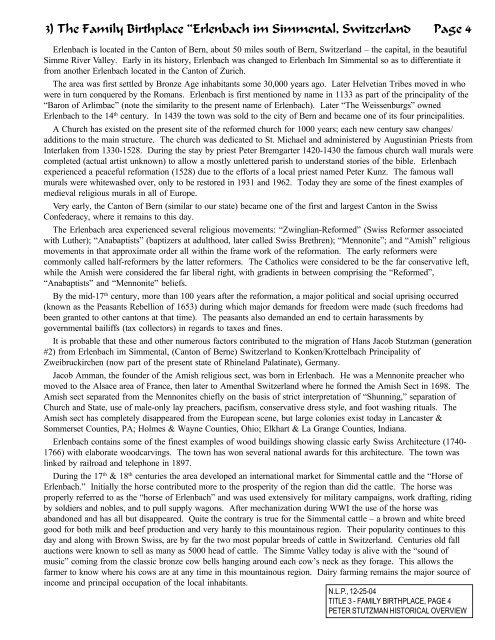A Historical Overview of the Peter Stutzman Family - Yule Tree Farms
A Historical Overview of the Peter Stutzman Family - Yule Tree Farms
A Historical Overview of the Peter Stutzman Family - Yule Tree Farms
Create successful ePaper yourself
Turn your PDF publications into a flip-book with our unique Google optimized e-Paper software.
3) The <strong>Family</strong> Birthplace “Erlenbach im Simmental, Switzerland Page 4<br />
Erlenbach is located in <strong>the</strong> Canton <strong>of</strong> Bern, about 50 miles south <strong>of</strong> Bern, Switzerland – <strong>the</strong> capital, in <strong>the</strong> beautiful<br />
Simme River Valley. Early in its history, Erlenbach was changed to Erlenbach Im Simmental so as to differentiate it<br />
from ano<strong>the</strong>r Erlenbach located in <strong>the</strong> Canton <strong>of</strong> Zurich.<br />
The area was first settled by Bronze Age inhabitants some 30,000 years ago. Later Helvetian Tribes moved in who<br />
were in turn conquered by <strong>the</strong> Romans. Erlenbach is first mentioned by name in 1133 as part <strong>of</strong> <strong>the</strong> principality <strong>of</strong> <strong>the</strong><br />
“Baron <strong>of</strong> Arlimbac” (note <strong>the</strong> similarity to <strong>the</strong> present name <strong>of</strong> Erlenbach). Later “The Weissenburgs” owned<br />
Erlenbach to <strong>the</strong> 14 th century. In 1439 <strong>the</strong> town was sold to <strong>the</strong> city <strong>of</strong> Bern and became one <strong>of</strong> its four principalities.<br />
A Church has existed on <strong>the</strong> present site <strong>of</strong> <strong>the</strong> reformed church for 1000 years; each new century saw changes/<br />
additions to <strong>the</strong> main structure. The church was dedicated to St. Michael and administered by Augustinian Priests from<br />
Interlaken from 1330-1528. During <strong>the</strong> stay by priest <strong>Peter</strong> Bremgarter 1420-1430 <strong>the</strong> famous church wall murals were<br />
completed (actual artist unknown) to allow a mostly unlettered parish to understand stories <strong>of</strong> <strong>the</strong> bible. Erlenbach<br />
experienced a peaceful reformation (1528) due to <strong>the</strong> efforts <strong>of</strong> a local priest named <strong>Peter</strong> Kunz. The famous wall<br />
murals were whitewashed over, only to be restored in 1931 and 1962. Today <strong>the</strong>y are some <strong>of</strong> <strong>the</strong> finest examples <strong>of</strong><br />
medieval religious murals in all <strong>of</strong> Europe.<br />
Very early, <strong>the</strong> Canton <strong>of</strong> Bern (similar to our state) became one <strong>of</strong> <strong>the</strong> first and largest Canton in <strong>the</strong> Swiss<br />
Confederacy, where it remains to this day.<br />
The Erlenbach area experienced several religious movements: “Zwinglian-Reformed” (Swiss Reformer associated<br />
with Lu<strong>the</strong>r); “Anabaptists” (baptizers at adulthood, later called Swiss Brethren); “Mennonite”; and “Amish” religious<br />
movements in that approximate order all within <strong>the</strong> frame work <strong>of</strong> <strong>the</strong> reformation. The early reformers were<br />
commonly called half-reformers by <strong>the</strong> latter reformers. The Catholics were considered to be <strong>the</strong> far conservative left,<br />
while <strong>the</strong> Amish were considered <strong>the</strong> far liberal right, with gradients in between comprising <strong>the</strong> “Reformed”,<br />
“Anabaptists” and “Mennonite” beliefs.<br />
By <strong>the</strong> mid-17 th century, more than 100 years after <strong>the</strong> reformation, a major political and social uprising occurred<br />
(known as <strong>the</strong> Peasants Rebellion <strong>of</strong> 1653) during which major demands for freedom were made (such freedoms had<br />
been granted to o<strong>the</strong>r cantons at that time). The peasants also demanded an end to certain harassments by<br />
governmental bailiffs (tax collectors) in regards to taxes and fines.<br />
It is probable that <strong>the</strong>se and o<strong>the</strong>r numerous factors contributed to <strong>the</strong> migration <strong>of</strong> Hans Jacob <strong>Stutzman</strong> (generation<br />
#2) from Erlenbach im Simmental, (Canton <strong>of</strong> Berne) Switzerland to Konken/Krottelbach Principality <strong>of</strong><br />
Zweibruckirchen (now part <strong>of</strong> <strong>the</strong> present state <strong>of</strong> Rhineland Palatinate), Germany.<br />
Jacob Amman, <strong>the</strong> founder <strong>of</strong> <strong>the</strong> Amish religious sect, was born in Erlenbach. He was a Mennonite preacher who<br />
moved to <strong>the</strong> Alsace area <strong>of</strong> France, <strong>the</strong>n later to Amenthal Switzerland where he formed <strong>the</strong> Amish Sect in 1698. The<br />
Amish sect separated from <strong>the</strong> Mennonites chiefly on <strong>the</strong> basis <strong>of</strong> strict interpretation <strong>of</strong> “Shunning,” separation <strong>of</strong><br />
Church and State, use <strong>of</strong> male-only lay preachers, pacifism, conservative dress style, and foot washing rituals. The<br />
Amish sect has completely disappeared from <strong>the</strong> European scene, but large colonies exist today in Lancaster &<br />
Sommerset Counties, PA; Holmes & Wayne Counties, Ohio; Elkhart & La Grange Counties, Indiana.<br />
Erlenbach contains some <strong>of</strong> <strong>the</strong> finest examples <strong>of</strong> wood buildings showing classic early Swiss Architecture (1740-<br />
1766) with elaborate woodcarvings. The town has won several national awards for this architecture. The town was<br />
linked by railroad and telephone in 1897.<br />
During <strong>the</strong> 17 th & 18 th centuries <strong>the</strong> area developed an international market for Simmental cattle and <strong>the</strong> “Horse <strong>of</strong><br />
Erlenbach.” Initially <strong>the</strong> horse contributed more to <strong>the</strong> prosperity <strong>of</strong> <strong>the</strong> region than did <strong>the</strong> cattle. The horse was<br />
properly referred to as <strong>the</strong> “horse <strong>of</strong> Erlenbach” and was used extensively for military campaigns, work drafting, riding<br />
by soldiers and nobles, and to pull supply wagons. After mechanization during WWI <strong>the</strong> use <strong>of</strong> <strong>the</strong> horse was<br />
abandoned and has all but disappeared. Quite <strong>the</strong> contrary is true for <strong>the</strong> Simmental cattle – a brown and white breed<br />
good for both milk and beef production and very hardy to this mountainous region. Their popularity continues to this<br />
day and along with Brown Swiss, are by far <strong>the</strong> two most popular breeds <strong>of</strong> cattle in Switzerland. Centuries old fall<br />
auctions were known to sell as many as 5000 head <strong>of</strong> cattle. The Simme Valley today is alive with <strong>the</strong> “sound <strong>of</strong><br />
music” coming from <strong>the</strong> classic bronze cow bells hanging around each cow’s neck as <strong>the</strong>y forage. This allows <strong>the</strong><br />
farmer to know where his cows are at any time in this mountainous region. Dairy farming remains <strong>the</strong> major source <strong>of</strong><br />
income and principal occupation <strong>of</strong> <strong>the</strong> local inhabitants.<br />
N.L.P., 12-25-04<br />
TITLE 3 - FAMILY BIRTHPLACE, PAGE 4<br />
PETER STUTZMAN HISTORICAL OVERVIEW


